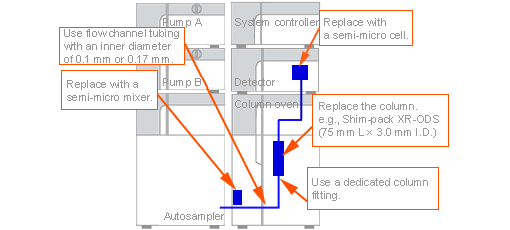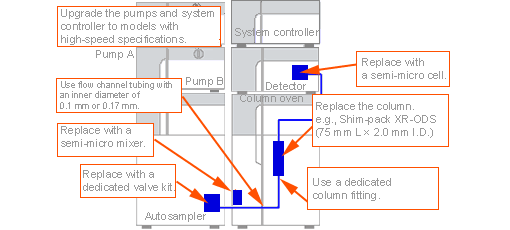Upgrading an Existing LC System to One That Enables a Reduction in Solvent Consumption
Here, we present three plans for upgrading an existing LC system to one that enables a reduction in solvent consumption. Each plan makes it possible to increase analysis speed without losing separation performance, thereby reducing both analysis time and solvent consumption. The appropriate columns and upgrade parts, and details on the applicable models, depend on the analytical conditions and chromatogram patterns. Please contact your Shimadzu representative for details on implementation.
| Analytical Conditions (Example) | |||||
|---|---|---|---|---|---|
| Details of Upgrade | Relative Solvent Consumption* | Flow Rate [mL/min] | Sample Injection Volume [µL] | Analysis Time [min] | |
| At Present | 150 mm L × 4.6 mm I.D. column used. | 1 | 1.0 | 10 | 60 |
| Plan 1 | Replace only the column (e.g., 75 mm L × 4.6 mm I.D.). | Approx. 1/2 | 1.0 | 10 | Approx. 30 |
| Plan 2 | In addition to the column (e.g. 75 mm L × 3 mm I.D.), replace the tubing, the detector cell, and the gradient mixer. | Approx. 1/5 | 1.0 | 4 | Approx. 12 |
| Plan 3 | Equip a Prominence system with UFLC specifications (e.g., 75 mm L × 2.0 mm I.D. column). | Approx. 1/10 | 0.5 | 2 | Approx. 12 |
Refer to Selecting Columns for details on the appropriate column to use with each plan.
Plan 1
With this plan, replacing the column with another that is half the length makes it possible to reduce the solvent consumption volume by approximately half. Replace only the column. In order to maintain separation performance, use a column containing packing consisting of particles with a small diameter (2.2 µm).
| Note 1: | Refer toChange to Shorter Columnfor details. |
| Note 2: | In gradient analysis, the time program and mixer capacity must be changed. Using the Method Transfer Program (contact your Shimadzu sales representative for details) allows the time program to be changed smoothly. |
| Note 3: | Because a shorter column is used, peaks with short elution times may be influenced by extra-column dispersion. In cases where Plan 1 is applied as indicated in the above example, there are constraints. For example, in chromatograms obtained in analysis (flow rate: 1 mL/min) performed with the current column, the elution time of the target component that is eluted fastest must, as a rough guide, be greater than 4 minutes. Also, under the same conditions, if the elution time of the target component that is eluted fastest is, as a rough guide, less than 8 minutes, the column connection tubing (i.e., the tubing connecting the autosampler outlet to the column inlet) must be replaced. |
Plan 2
With this plan, replacing several parts of an existing LC system (e.g., LC-VP series) with optional parts makes it possible to reduce the solvent consumption volume to approximately one-fifth of the current volume.

| Note 1: | In addition to replacing the flow channel tubing with tubing that has an inner diameter of 0.1 mm (or 0.17 mm), use a semi-micro cell to suppress extra-column dispersion. Also, in gradient analysis, replace the mixer with a semi-micro mixer to reduce gradient delay. Refer toMigration to High-Speed Analysisfor details. |
| Note 2: | Contact us if you are performing high-sensitivity absorbance detection using a mobile phase that contains substances with ultraviolet absorption, such as trifluoroacetic acid (TFA). |
| Note 3: | Check that a plunger cleaning kit is used with the existing LC system. |
Plan 3
With this plan, upgrading an existing LC system (Prominence series) to an ultrafast “UFLC” system makes it possible to reduce the solvent consumption volume to approximately one-tenth of the current volume. With UFLC, a variety of analytical conditions can be handled; therefore, solvent consumption can be reduced efficiently.

Selecting Columns
If you are replacing your current column with a shorter one, you must check that separation from impurities is not affected. In order to ensure that separation capability and selectivity are not changed more than necessary, it is desirable that you select a column for which the packing carbon content, the degree of end-capping, and the ODS modification rate are the same as in the column currently being used. (In the case of the Shim-pack XR-ODS, the carbon content is 18.4%, the surface-processing type is end-cap processing, and the surface modification is monofunctional.)
The first choice isPlan 1. As explained previously, use a column of half the length with a smaller particle diameter. For example, if you are using a 150 mm × 4.6 mm I.D. (particle diameter: 5 µm) column, switching to a 75 mm × 4.6 mm I.D. (particle diameter: 2.2 µm) column makes it possible to halve the analysis time while maintaining separation performance.
| Item | P/N | |
|---|---|---|
| Shim-pack XR-ODS (75 mm × 4.6 mm I.D.) | 228-41607-93 | |
| Shim-pack XR-ODS (100 mm × 4.6 mm I.D.) | 228-41607-94 | |
Selecting a column that is shorter and that has a smaller inner diameter makes it possible to significantly reduce the analysis time while maintaining separation performance. However, because of the influence of dispersion inside the tubing and the detector cell, explained inMigration to High-Speed Analysis, the existing equipment must be upgraded as described inPlans 2and3. We have put together various examples of configurations based on the Shim-pack XR-ODS. Refer to these examples when considering analytical conditions. For the documents related, Please contact Shimadzu local representative. In addition to ODS columns, there are high-speed analysis columns consisting of silica modified with octyl (C8) or propylphenyl groups.
| Item | P/N | Features | |
|---|---|---|---|
| Shim-pack XR-ODS (75 mm × 3.0 mm I.D.) | 228-41606-93 | Exhibits a theoretical plate number comparable with that of a standard 150-mm column. Suitable for high-speed analysis in the field of general-purpose LC. | |
| Shim-pack XR-ODS (75 mm × 2.0 mm I.D.) | 228-41605-93 | Suitable for semi-micro analysis and LC-MS high-speed analysis. | |
| Shim-pack XR-C8 (75 mm × 3.0 mm I.D.) | 228-59902-93 | Surface-modified with octyl groups. Suitable for the analysis of components that are strongly retained by ODS, such as lipid-soluble vitamins. Also available in dimensions of 75 mm × 2.0 mm I.D. (228-59901-93). | |
| Shim-pack XR-Phenyl (75 mm × 3.0 mm I.D.) | 228-59904-93 | Surface-modified with propylphenyl groups. The separation selectivity differs from that of ODS columns (e.g., strong retention of aromatic compounds). Also available in dimensions of 75 mm × 2.0 mm I.D. (228-59903-93). | |


